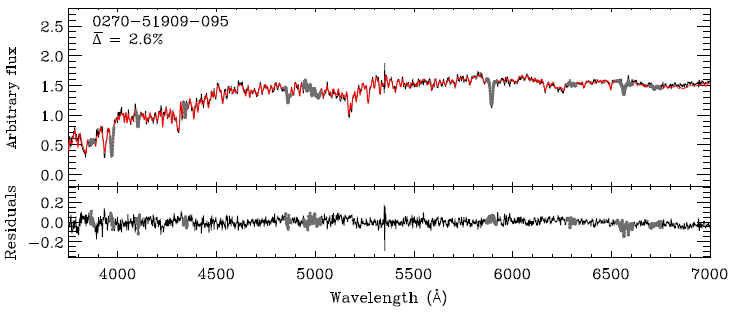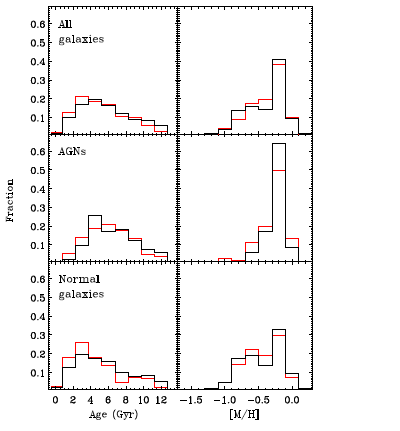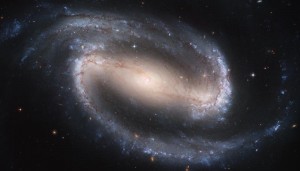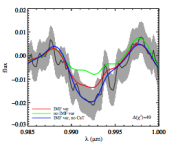- Paper title: Bars rejuvenating bulges? Evidence from stellar population analysis
- Authors: Paula Coelho and Dimitri A. Gadotti
- First author’s affiliation:Núcleo de Astrofísica Teórica, Universidade Cruzeiro do Sul, São Paulo, Brasil
Summary
As you may recall from Nathan Sanders’ April post, some spiral galaxies have central bulges with high concentrations of stars. Coelho and Gadotti examine a sample of 575 of these galaxies to investigate whether the presence or absence of a bar (a bar-shaped overdensity of stars) influences the rate of star formation in the central bulge. Astronomers expect to see a higher star formation rate in the bulges of barred galaxies because bars can transport gas from the outer regions of the galaxy into the center and supply fuel for growing stars. Previous detections of star-formation indicators (such as enhanced Hα emission) have indicated that the current star formation rates are higher in barred spirals than in unbarred spirals, but Coelho and Gadotti take the alternative approach of determining the ages of the stellar populations in the bulges. They find that the bulges of barred galaxies are systematically younger than the bulges of unbarred galaxies, which is consistent with the expectation that bars should promote star formation.
The Galaxy Sample
In a previous paper, Gadotti derived stellar masses, bulge stellar masses, bar properties, and other parameters for a sample of face-on galaxies observed by Sloan Digital Sky Survey (SDSS). All of the galaxies had stellar masses above 10^10 solar masses and redshifts between 0.02 and 0.07. Selecting face-on galaxies reduced the effect of dust and simplified the process of identifying bars and bulges in the galaxies. In this paper, Coelho and Gadotti subdivided the sample of spiral galaxies with bulges into an unbarred sample of 324 galaxies and a barred sample of 251 galaxies. They then compared the stellar mass distributions of the two samples using a Kolmogorov-Smirnov (K-S) test. As explained in a previous astrobite, a K-S test determines the maximum distance between two cumulative distributions in order to determine whether the two samples are consistent with being drawn from the same distribution. In this case, Coelho and Gadotti find that the barred and unbarred galaxies are drawn from similar stellar mass distributions with a difference of less than 1σ. Since the two populations are consistent with the same stellar mass distribution, Coelho and Gadotti do not need to be concerned about differences in the stellar mass distribution introducing a bias into their analysis.
Methods
Coelho and Gadotti use the code STARLIGHT (Cid-Fernandes et al. 2005) to transform their SDSS spectra into stellar bulge ages. For each pixel in each galaxy image, STARLIGHT determines the combination of stellar populations that produces a spectrum with the best match to the observed spectrum. The figure below shows an example fit with the observed spectrum in black and the STARLIGHT model spectrum in red.

A STARLIGHT fit showing the best-fit model spectrum (red) to the observed SDSS spectrum (black). The regions marked in gray were not used in the fit due to bad pixels and spectral lines from AGN. The residuals (observed spectrum - model) are displayed in the bottom panel. Figure 1 from Coelho & Gadotti 2011.
The code accounts for stellar motions and includes a correction for extinction due to dust. The authors use spectral models from Vazdekis et al. 2010, which cover an age range of 63 million years to 18 billion years and vary in metallicity from [M/H]=-2.32 to +0.22 log(solar metallicity).
Results

Normalized distributions of ages (left column) and metallicities (right) for the stellar populations in bulges in barred (red) and unbarred (black) galaxies. The top row displays the full sample, the middle row is the AGN sample (106 barred, 81 unbarred), and the bottom row is the normal (non-AGN) galaxy sample. Figure 3 from Coelho & Gadotti 2011.
After running STARLIGHT to determine the stellar populations for each bulge, the authors compared the distributions of ages and metallicities for the barred and unbarred samples. As shown in the top panel of the figure to the right, barred galaxies have more young stellar populations than do unbarred galaxies. However, when the authors split the sample into active galactic nuclei (AGN; see Evan’s astrobite for an introduction) and normal (non-AGN) galaxies, they do not see a difference in the age populations for AGN while the excess of young populations in the barred sample is enhanced for normal galaxies. Coelho and Gadotti report that the difference between the bulge age distributions in normal barred and unbarred galaxies is significant at nearly the 4σ level.
If they compare normal barred galaxies and unbarred galaxies with similar stellar bulge masses, the authors find that the bulge age distribution is similar for low stellar bulge masses but not for high stellar bulge masses. At high stellar mass, the unbarred galaxy age distribution has a single peak while the barred galaxies have a bimodal age distribution with a younger peak at 4.7 billion years and an older peak at 10.4 billion years. Coelho and Gadotti view the bimodality of the bulge age distribution of barred galaxies as evidence that the presence of a bar influences the bulge building process because bimodality is not observed in the bulge age distribution of unbarred galaxies.





